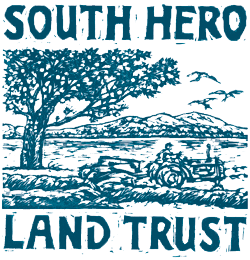Keeler Bay Action Plan Kicks Into High Gear
Fall 2022 Newsletter
Underwater Forests
Margaret Murphy from Vermont Fish & Wildlife dipped her hand into the shallow water beneath her kayak, gently combing through the leaves of aquatic plants as her momentum carried her on. Unlike invasive Eurasion milfoil, these native plants actually benefit the lake, she explained to the group of paddlers gathered around her during the recent “Kayak the Bay” event at Keeler Bay with the Grand Isle County Natural Resources Conservation District (GICNRCD).
Not only do they clean the water by filtering pollutants and uptaking excess nutrients, they also provide habitat for many species of native fi sh, mussels, insects, amphibians and other aquatic life that call the lake home. Rather than look at underwater vegetation as “weeds”, Margaret encouraged us to see instead a thriving underwater forest, an ecosystem that is perhaps just as beautiful and important as any forest on land.
Despite its beauty, the paddlers were also able to see up close some of the problems in Keeler Bay. As we crossed into deeper water, floating mats of detached Eurasion milfoil drifted by. This invasive plant thrives wherever native aquatic vegetation is disturbed or removed. It also grows where erosion from creeks causes rocky shallows to get covered in silt. Once it’s established, it can out-compete native vegetation, reducing diversity of aquatic plants, fish, and mollusks. When it gets dislodged, it can gather in huge floating mats that surround beaches, docks, and boat ramps, clogging access to the lake for everyone.
The good news is, by addressing streambank and shoreline erosion, we can not only keep invasive milfoil at bay, but also protect water quality. Throughout the paddle Margaret pointed out trees and shrubs along the shoreline and how they were anchoring the soil, preventing erosion that brings sedimentation and excess nutrients to the bay, such as phosphorus, the main culprit behind the cyanobacteria blooms of increasing frequency.
It Takes a Village
The “Kayak the Bay” event was an outreach component of a larger project by SHLT and GICNRCD. With funding and support from the Lake Champlain Basin Program, we are working together with state and regional water quality experts and local community members to assess water quality issues and identify potential solutions in Keeler Bay.
This past spring, GICNRCD & SHLT convened a local working group of residents, shoreline landowners, farmers, and business owners to lead the project. During the summer, the team hired Fitzgerald Environmental, a well-respected local water quality consulting firm, to begin gathering data and putting together a “Watershed Action Plan” for Keeler Bay. This plan will act as a guide as our community responds to the challenges facing the bay, including excess phosphorus and other issues.
During the fall the team is reaching out to local landowners who may be interested in doing a potential water quality project on their land. Projects may include wetland restoration, road drainage improvements, buffer plantings, and more. Once we assemble a handful of preliminary project designs with landowners who are willing to partner with us, we’ll have the necessary ingredients to seek grant funding to pursue some of these projects to clean up the bay. The great thing is that partnering landowners will not only benefit in terms of reducing property loss caused by erosion of streambanks or shorelines, but also know they are making a positive impact on the health of the lake.
We All Play a Part
Back at the paddle, Margaret stressed the importance of everyone getting involved. Whether you own land in the watershed or not, she explained, anyone who cares about the lake can make a difference. She shared some easy tips we all can do, such as “raising the blade” when we mow so our lawns can filter rainwater more efficiently, and picking up our pet waste to prevent excess nutrients and pathogens from getting into the lake.
For those interested in learning more about the challenges Keeler Bay and what you can do to help, project lead Molly Varner at GICNRCD, with help from SHLT, put together an interactive online Storymap of the project. This interactive resource will take you on a multimedia journey throughout the greater Lake Champlain watershed, with special focus on Keeler Bay in South Hero.
>> Check out the Keeler Bay Storymap at:
This project has been funded wholly or in part by the United States Environmental Protection Agency under assistance agreement (LC-00A00695-0) to NEIWPCC in partnership with the Lake Champlain Basin Program.
